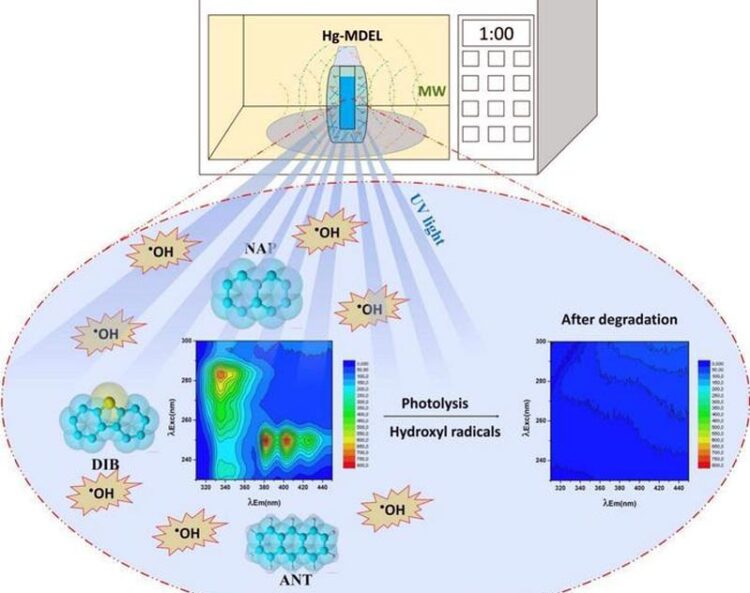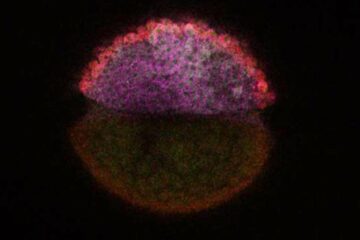Results for control of pollutants in water

The mixture of pollutants was degraded by means of a photochemical system in which a light source is activated by microwave radiation
Credit: CDMF
Brazilian scientists tested a simple and sustainable method for monitoring and degrading a mixture of polycyclic aromatic hydrocarbons, compounds present in fossil fuels and industrial waste.
An article published in the journal Catalysis Communications describes a simple, efficient and sustainable approach to the degradation and quantitative monitoring of a mixture of polycyclic aromatic hydrocarbons (PAHs), emerging pollutants that contaminate various ecosystems owing to oil and other fossil fuel spills and improper disposal of industrial waste.
Emerging pollutants are chemical compounds that have recently been identified as harmful to human health and the environment but are not regularly monitored and cannot be removed by conventional wastewater treatment methods. Examples include bisphenol (used in certain types of plastic), some pesticides, and substances found in personal care products and medications.
In pursuit of solutions to this problem, researchers in Brazil affiliated with the Federal University of São Carlos (UFSCar), São Paulo State University (UNESP) and the Federal University of Paraíba (UFPB) prepared a mixture containing low levels of naphthalene, anthracene and dibenzothiophene in surface water, simulating the natural environment. They used excitation-emission matrix (EEM) fluorescence spectroscopy as a higher-order method of analysis and calibration coupled with parallel factor analysis for data processing, whereby they separated the spectral components of the mixture in order to identify and quantify each pollutant, as well as other potential compounds present in natural water.
This methodology enabled each analysis to be completed in less than two minutes, without production of any residue or the need for more costly and sophisticated techniques, such as chromatography.
The mixture was then degraded using a photochemical system in which a lamp is activated by microwave radiation. The system degraded between 88% and 100% of the organic pollutants in only a minute. This high performance was associated with water photolysis that effectively generated hydroxyl radicals (oxidizing species capable of degrading organic pollutants at high speed).
According to Kelvin C. Araújo, first author of the article and a researcher at the Center for Development of Functional Materials (CDMF), a Research, Innovation and Dissemination Center (RIDC) funded by FAPESP and hosted by UFSCar, one of the highlights of the study was the choice of PAH monitoring method. Chromatography, the usual method, limits progress in this type of research in many parts of the world because the equipment is expensive and the technique requires more sophisticated training, he explained.
In this study, the researchers used a spectrofluorometer, which is more affordable for many laboratories. The analysis is up to five times faster than in chromatography, and no residue is produced after the process. Moreover, Araújo noted, demand for more accessible methods was detected by the group, which has long studied water treatment using chromatography as its main analytical technique.
Photochemical system
Another significant aspect of the study was the use of a microwave-activated photochemical system to degrade the PAHs. According to Ailton Moreira, currently a researcher at UNESP Institute of Chemistry in Araraquara and a co-author of the article, efficiently and quickly degrading emerging pollutants without the use of catalysts is a major challenge.
“The challenge is even more daunting when you’re working with mixtures of pollutants in natural water because of the many potential inhibitors of the degradation process, but the photochemical system performed outstandingly,” Moreira said, adding that the same system had already proved effective in studies involving degradation of agricultural and pharmaceutical waste. Based on the findings described in the article, the photochemical system could be used on a far larger scale – in wastewater treatment plants, for example.
The authors confirm that both the analytical method and the degradation process will be the focus of future studies in different projects led by members of the group. Next steps will include application of these technologies at a wastewater treatment plant in Gavião Peixoto, a city in São Paulo state, to monitor and degrade emerging pollutants.
About São Paulo Research Foundation (FAPESP)
The São Paulo Research Foundation (FAPESP) is a public institution with the mission of supporting scientific research in all fields of knowledge by awarding scholarships, fellowships and grants to investigators linked with higher education and research institutions in the State of São Paulo, Brazil. FAPESP is aware that the very best research can only be done by working with the best researchers internationally. Therefore, it has established partnerships with funding agencies, higher education, private companies, and research organizations in other countries known for the quality of their research and has been encouraging scientists funded by its grants to further develop their international collaboration. You can learn more about FAPESP at www.fapesp.br/en and visit FAPESP news agency at www.agencia.fapesp.br/en to keep updated with the latest scientific breakthroughs FAPESP helps achieve through its many programs, awards and research centers. You may also subscribe to FAPESP news agency at http://agencia.fapesp.br/subscribe.
Journal: Catalysis Communications
DOI: 10.1016/j.catcom.2023.106834
Article Title: Fast and efficient processes for oxidation and monitoring of polycyclic aromatic hydrocarbons in environmental matrices
Article Publication Date: 28-Dec-2023
Media Contact
Heloisa Reinert
Fundação de Amparo à Pesquisa do Estado de São Paulo
hreinert@fapesp.br
Cell: 55-11966392552
Original Source
All latest news from the category: Life Sciences and Chemistry
Articles and reports from the Life Sciences and chemistry area deal with applied and basic research into modern biology, chemistry and human medicine.
Valuable information can be found on a range of life sciences fields including bacteriology, biochemistry, bionics, bioinformatics, biophysics, biotechnology, genetics, geobotany, human biology, marine biology, microbiology, molecular biology, cellular biology, zoology, bioinorganic chemistry, microchemistry and environmental chemistry.
Newest articles

Attosecond core-level spectroscopy reveals real-time molecular dynamics
Chemical reactions are complex mechanisms. Many different dynamical processes are involved, affecting both the electrons and the nucleus of the present atoms. Very often the strongly coupled electron and nuclear…

Columbia researchers “unzip” 2D materials with lasers
The new technique can modify the nanostructure of bulk and 2D crystals without a cleanroom or expensive etching equipment. In a new paper published on May 1 in the journal…

Decoding development: mRNA’s role in embryo formation
A new study at Hebrew University reveals insights into mRNA regulation during embryonic development. The study combines single-cell RNA-Seq and metabolic labeling in zebrafish embryos, distinguishing between newly-transcribed and pre-existing…





















